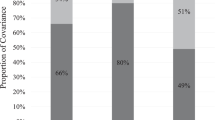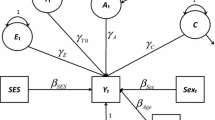Abstract
Although research findings have revealed that both genetic and environmental factors contribute to variation in IQ at the individual level, no studies have examined how genetic differences contribute to differences in IQ within and between families. The current study uses data drawn from the National Longitudinal Study of Adolescent Health (Add Health) to examine the potential role genetic factors play in shaping differences in IQ scores within and between families. The results revealed that while genetic variation between family members did not significantly predict differences in IQ scores, family-level dopaminergic risk scores did significantly predict differences in family-level IQ. The implications of the results are elaborated upon, and suggestions for future research are discussed.




Similar content being viewed by others
Notes
Due to the identification of outliers, only families with a standardized IQ score greater than 60 on all IQ measures (wave I, wave III, and the composite measures) were included in the final analytic sample. To check the robustness of the findings with respect to outliers, the results were reanalyzed with all scores included in the analyses. The pattern of results was virtually identical to those reported with the outliers removed.
Only two siblings per household were examined in the current study. For households with more than one sibling, two siblings were randomly chosen. Additionally, since MZ twins are genetically identical, they were excluded from the within-family analysis, but were included in the between-family analysis.
All figures presented in the current study present genetic risk in 0.5 increments even though the distribution of the genes in individuals does not naturally occur in 0.5 increments. Rather, the dopamine risk scores presented in the figures are averages of each family members’ individual scores, making it possible for families to have a dopaminergic risk score that falls between two whole numbers.
References
Bartels M, Rietveld MJH, Van Baal GCM, Boomsma DI (2002) Heritability of educational achievement in 12-year-olds and the overlap with cognitive ability. Twin Res Hum Genet 5:544–553
Beaver KM, Wright JP (2011a) School-level genetic variation predicts school-level verbal IQ scores: results from a sample of American middle and high schools. Intelligence 39:193–197
Beaver KM, Wright JP (2011b) The association between county-level IQ and county-level crime rates. Intelligence 39:22–26
Beaver KM, Delisi M, Vaughn MG, Wright JP (2010a) The intersection of genes and neuropsychological deficits in the prediction of adolescent delinquency and low self-control. Int J Offender Ther Comp Criminol 54:22–42
Beaver KM, Vaughn MG, Wright JP, DeLisi M, Howard MO (2010b) Three dopaminergic polymorphisms are associated with academic achievement in middle and high school. Intelligence 39:22–26
Belsky J, Beaver KM (2011) Cumulative-genetic plasticity, parenting and adolescent self-regulation. J Child Psychol Psychiatry 52:619–626
Bergen SE, Gardner CO, Kendler KS (2007) Age-related changes in heritability of behavioral phenotypes over adolescence and young adulthood: a meta-analysis. Twin Res Hum Genet 10:423–433
Berman SM, Noble EP (1995) Reduced visuospatial performance in children with the D2 dopamine receptor A1 allele. Behav Genet 25:45–58
Boomsma DI (1993) Current status and future prospects in twin studies of the development of cognitive abilities: Infancy to old age. In: Bouchard TJ, Propping P (eds) Twins as a tool of behavioral genetics. Wiley, Chichester, pp 67–82
Boomsma DI, van Baal GCM (1998) Genetic influences on childhood IQ in 5- and 7- year-old Dutch twins. Dev Neuropsychol 14:115–126
Bouchard TJ, McGue M (2003) Genetic and environmental influences on human psychological differences. J Neurobiol 54:4–45
Braver TS, Barch DM, Cohen JD (1999) Cognition and control in schizophrenia: a computational model of dopamine and prefrontal function. Biol Psychiatry 46:312–328
Brookes KJ, Mill J, Guindalini C, Curran S, Xu X, Knight J, Chen CK et al (2006) A common haplotype of the dopamine transporter gene associated with attention-deficit/hyperactivity disorder and interacting with maternal use of alcohol during pregnancy. Arch Gen Psychiatry 63:74–81
Brooks-Gunn J, Klebanov PK, Duncan GJ (1996) Ethnic differences in children’s intelligence test scores: role of economic deprivation, home environment, and maternal characteristics. Child Dev 67:396–408
Bubser M, Schmidt WJ (1990) 6-hydroxydopamine lesion of the rat prefrontal cortex increases locomotor activity, impairs acquisition of delayed alternation tasks, but does not affect uninterrupted tasks in the radial maze. Behav Brain Res 37:157–168
Deary IJ, Spinath FM, Bates TC (2006) Genetics of intelligence. Eur J Hum Genet 14:690–700
Deary IJ, Johnson W, Houlihan LM (2009) Genetic foundations of human intelligence. Hum Genet 126:215–232
Frendreis JP (1983) Explanation of variation and detection of covariation: the purpose and logic of comparative analysis. Comp Political Stud 16:255–272
Gasparini M, Fabrizio E, Bonifati V, Meco G (1997) Cognitive improvement during tolcapone treatment in Parkinson’s disease. J Neural Transm 104:887–894
Groeneveld RA, Meeden G (1984) Measuring skewness and kurtosis. J R Stat Soc Ser D (The Statistician) 33:391–399
Harris KM, Florey F, Tabor J, Bearman PS, Jones J, Udry JR (2003) The National Longitudinal Study of Adolescent Health: research design. http://www.cpc.unc.edu/projects/addhealth/design
Harris KM, Halpern CT, Smolen A, Haberstick BC (2006) The National Longitudinal Study of Adolescent Health (Add Health) Twin data. Twin Res Hum Genet 9:988–997
Herrnstein RJ, Murray C (1994) The bell curve: intelligence and class structure in American life. Free Press Paperbacks, New York
Hopfer CJ, Timberlake D, Haberstick BC, Lessem JM, Ehringer MA, Smolen A et al (2005) Genetic influences on quantity of alcohol consumed by adolescents and young adults. Drug Alcohol Depend 78:187–193
Kanazawa S (2008) IQ and the health of states. Biodemogr Soc Biol 54:200–213
Li S, Zhao JH, Luan J, Ekelund U, Luben RN, Khaw KT et al (2010) Physical activity attenuates the genetic predisposition to obesity in 20,000 men and women from EPIC-Norfolk prospective population study. PLoS Med 7:1–9
Lynn R (2008) The global bell curve: race, IQ, and inequality worldwide. Washington Summit Publishers, Augusta
Lynn R, Vanhanen T (2002) IQ and the wealth of nations. Praeger, Westport
Lynn R, Vanhanen T (2006) IQ & global inequality. Washington Summit Publishers, Augusta
McDaniel MA (2006) Estimating state IQ: measurement challenges and preliminary correlates. Intelligence 34:607–619
Mehta MA, Hinton EC, Montgomery AJ, Bantick RA, Grasby PM (2005) Sulpiride and mnemonic function: effects of a dopamine D2 receptor antagonist on working memory, emotional memory and long-term memory in healthy volunteers. J Psychopharmacol 19:29–38
Moises HW, Frieboes RM, Spelzhaus P, Yang L, Köhnke M, Herden-Kirchhoff O, Vetter P et al (2001) No association between dopamine D2 receptor gene (DRD2) and human intelligence. J Neural Transm 108:115–121
Neisser U, Boodoo G, Bouchard TJJ, Boykin AW, Brody N, Ceci SJ, Halpern DF et al (1996) Intelligence: knowns and unknowns. Am Psychol 51:77–101
Perry JC, Da Cunha C, Anselmo-Franci J, Andreatini R, Miyoshi E, Tufik S et al (2004) Behavioural and neurochemical effect of phosphatidylserine in MPTP lesion of the substantia nigra of rats. Eur J Pharmacol 484:225–233
Pesta BJ, McDaniel MA, Bertsch S (2010) Toward an index of well-being for the fifty U.S. states. Intelligence 38:160–168
Petrill S, Wilkerson B (2000) Intelligence and achievement: a behavioral genetic perspective. Educ Psychol Rev 12:185–199
Petrill SA, Plomin R, McClearn GE, Smith DL, Vignetti S, Chorney MJ, Chorney K et al (1997) No association between general cognitive ability and the A1 allele of the D2 dopamine receptor gene. Behav Genet 27:29–31
Piantadosi S, Byar DP, Green SB (1988) The ecological fallacy. Am J Epidemiol 127:893–904
Plomin R (1999) Genetics and general cognitive ability. Nature 402:C25–C29
Plomin R, DeFries JC, McClearn GE, McGuffin P (2008) Behavioral genetics, 5th edn. Worth Publishers, New York
Previc FH (1999) Dopamine and the origins of human intelligence. Brain Cogn 41:299–350
Reuter M, Peters K, Schroeter K, Koebke W, Lenardon D, Bloch B, Hennig J (2005) The influence of the dopaminergic system on cognitive functioning: a molecular genetic approach. Behav Brain Res 164:93–99
Rowe DC, Almeida DM, Jacobson KC (1999a) School context and genetic influences on aggression in adolescence. Psychol Sci 10:277–280
Rowe DC, Jacobson KC, van den Oord EJCG (1999b) Genetic and environmental influences on vocabulary iq: parental education level as moderator. Child Dev 70:1151–1162
Samuelson PA (1955) Economics: an introductory analysis. McGraw-Hill, New York
Scarr S (1992) Developmental theories for the 1990s: development and individual differences. Child Dev 62:1–19
Scarr S, Weinberg RA (1978) The influence of “family background” on intellectual attainment. Am Sociol Rev 43:674–692
Tsai SJ, Yu YWY, Lin CH, Chen TJ, Chen SP, Hong CJ (2002) Dopamine D2 receptor and N-methyl-D-aspartate receptor 2B subunit genetic variants and intelligence. Neuropsychobiology 45:128–130
van der Sluis S, Willemsen G, de Geus E, Boomsma D, Posthuma D (2008) Gene-environment interaction in adults’ IQ scores: measures of past and present environment. Behav Genet 38:348–360
van Leeuwen M, van den Berg SM, Boomsma DI (2008) A twin-family study of general IQ. Learn Individ Differ 18:76–88
Watson D, Klohnen EC, Casillias A, Simms EN, Haig J, Berry DS (2004) Match makers and deal breakers: analyses of assortative mating in newlywed couples. J Pers 72:1029–1068
Acknowledgments
This research uses data from Add Health, a program project directed by Kathleen Mullan Harris and designed by J. Richard Udry, Peter S. Bearman, and Kathleen Mullan Harris at the University of North Carolina at Chapel Hill, and funded by grant P01-HD31921 from the Eunice Kennedy Shriver National Institute of Child Health and Human Development, with cooperative funding from 23 other federal agencies and foundations. Special acknowledgment is due to Ronald R. Rindfuss and Barbara Entwisle for assistance in the original design. Information on how to obtain the Add Health data files is available on the Add Health website (http://www.cpc.unc.edu/addhealth). No direct support was received from grant P01-HD31921 for this analysis.
Author information
Authors and Affiliations
Corresponding author
Rights and permissions
About this article
Cite this article
Schwartz, J.A., Beaver, K.M. Examining the effects of dopamine genes on verbal IQ within and between families. J Neural Transm 120, 477–486 (2013). https://doi.org/10.1007/s00702-012-0881-0
Received:
Accepted:
Published:
Issue Date:
DOI: https://doi.org/10.1007/s00702-012-0881-0




